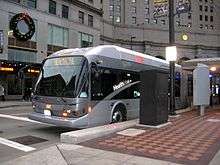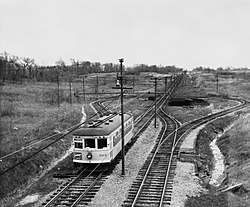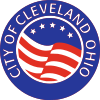Greater Cleveland Regional Transit Authority
The Greater Cleveland Regional Transit Authority (officially the GCRTA, but historically and locally referred to as the RTA) is the public transit agency for Cleveland, Ohio, United States and the surrounding suburbs of Cuyahoga County. RTA is the largest transit agency in Ohio, providing over 44 million trips to residents and visitors of the Cleveland area in 2010. RTA owns and operates the RTA Rapid Transit rail system (called "The Rapid" by area residents), which consists of one heavy rail line (the Red Line) and three light rail lines (Blue, Green, Waterfront). The bulk of RTA's service consists of buses, including regular routes, express or flyer buses, loop and paratransit buses. In December 2004, RTA adopted a revised master plan, Transit 2025, in which several rail extensions, bus line improvements and transit oriented developments are discussed.[2]
 | |
.jpg) A Red Line train at Airport station | |
| Founded | December 30, 1974 |
|---|---|
| Headquarters | 1240 West 6th Street, Downtown, Cleveland, Ohio |
| Locale | Cleveland, Ohio |
| Service type | Bus and Rapid Transit |
| Routes | Bus: 44, Rail: 4, Trolley: 4, BRT: 3 |
| Fleet | Bus: 391, Rail: 92, Trolley: 12, BRT: 40 (Not including the MetroHealth BRT Line) |
| Daily ridership | Total: 39.6 million (2017) |
| Chief executive | India Birdsong[1] |
| Website | http://riderta.com |
RTA's major predecessor, the Cleveland Transit System, was the first transit system in the western hemisphere to provide direct rapid transit service from a city's downtown to its major airport.[3]
In 2007, RTA was named the best public transit system in North America by the American Public Transportation Association, for "demonstrating achievement in efficiency and effectiveness."[4]
History
The GCRTA was established December 30, 1974,[5] and on September 5, 1975 assumed control of the Cleveland Transit System, which operated the heavy rail line from Windermere to Cleveland Hopkins Airport and the local bus systems, and Shaker Heights Rapid Transit (the descendant of a separate streetcar system formed by the Van Sweringen brothers to serve their Shaker Heights development), which operated the two interurban light rail lines from downtown to Shaker Heights. CTS had been formed when the city of Cleveland took over the old Cleveland Railway Company. However, with Cleveland's dwindling population over the previous two decades, its revenue dwindled significantly. The problem really manifested itself with a 17-day strike in July 1970. City and county leaders concluded that a regional approach was the only way to save it.[3]
A month after its formation, RTA assumed control over the suburban bus systems operated by Maple Heights, North Olmsted, Brecksville, Garfield Heights and Euclid.[3]
The RTA had to undertake a number of renovations to the rail system, as the Shaker Heights lines (renamed the Blue and Green lines) had not been significantly renovated since their creation in 1920. They were largely rebuilt by 1981 and the downtown station at Cleveland Union Terminal, later renamed Tower City Center, was heavily rebuilt by 1987. In 1994, a walkway and skyway was added from the Tower City station to the Gateway Sports and Entertainment Complex and the Blue and Green lines were extended to the North Coast Harbor area by 1996.
Seventy-five Cleveland Transit System PCC streetcars were sold in 1952 to Toronto to be used by the Toronto Transit Commission (TTC). The last of the Cleveland PCC models operated for 30 years in Toronto until 1982. Cleveland Transit also sold 8 Marmon-Herrington TC-44 trolleybuses in 1963 to the TTC, but scrapped and used for the Western Flyer E-700A trolleybuses from 1969 to 1971.
RTA has equipped all of its mainline buses with bicycle carriers. Each bus can carry two to three bicycles. Bicycles are also allowed on rapid transit trains (with a maximum limit of two per car) at all times, although operators have discretion to refuse bicycles if a train is overcrowded. Bicycles are not allowed access to/from the Public Square/Tower City Station through the shopping areas of Tower City Center. However, an elevator connection is permitted between the station lobby and street level, at Prospect Avenue via the south-side doors. Bicycles are also allowed to transfer between trains at Tower City Station. There is no additional charge for taking bicycles on RTA.
HealthLine

In 2005, RTA began building a bus rapid transit line along Euclid Avenue from Public Square to University Circle and then to East Cleveland. This was originally to be a subway line running under Euclid Avenue, but the high cost of such a project caused it to be reduced in scope, resulting in the current bus rapid transit project. Vehicles operate in an exclusive center median busway from Public Square to Stokes Blvd. and transition to curbside running through University Circle to the Windermere Rapid Transit Station in East Cleveland. The vehicles are low-floor, articulated 63 feet (19 m) buses.
Naming rights for the line were purchased by the Cleveland Clinic and University Hospitals for twenty-five years. The BRT route, originally named the "Silver Line", which serves the two major health industry employers in Cleveland, is named the HealthLine.[6]
As sections were completed, they were opened to traffic; the entire stretch within the project area was open by October 24, 2008[7] as part of its grand opening October 24–26, 2008.[8]
Cleveland State Line
The Greater Cleveland Regional Transit Agency's new bus-rapid transit Cleveland State Line opened December 8, 2014. It comprises a fleet of 16 articulated, 60-foot buses that run along the 4.1-mile, upgraded route from West Clifton Boulevard in Lakewood to Lake Avenue in Cleveland and then into downtown, replacing the existing Clifton bus service.
The $20 million beautification and bus-efficiency rebuild of the Clifton corridor was intended to make the avenue more appealing to walkers, transit riders and car drivers. It also is designed to spark transit-oriented commercial and residential growth, much like RTA's flagship BRT HealthLine along Euclid Avenue. It incorporates many of the features of the HealthLine, including consolidated bus stops, new stations, bus-only lanes, a new traffic signal system, and landscaping.[9]
Funding
When RTA was formed, Cuyahoga County voters approved a 1% county-wide sales tax, which constitutes about 70% of its operating revenue. This funding source has helped RTA maintain a higher level of service than other transit agencies in comparable cities and it also helps RTA retain some degree of political autonomy. However, it also makes RTA unusually susceptible to economic downturns.
In recent years, RTA has undertaken great efforts to improve efficiency and eliminate unnecessary costs. These efforts have included mergers with the two remaining autonomous transit agencies in Cuyahoga County, the North Olmsted Municipal Bus Line and Maple Heights Transit, and the redesigning of its routes in the suburban areas southeast, west, and south of Cuyahoga County.

CTS fleet
- 1946 Pullman PCC A11 (49) and 1946 St. Louis Car Company A12 (24) - all sold to Toronto in 1952 and all retired by TTC.
- Marmon-Herrington TC48-T5 and TC44-T7 trolleybus - ordered 49 in 1951 and 1952 and retired in 1960s (sold to Mexico City's Servicio de Transportes Eléctricos and since retired)[10]
See also
- Cleveland railroad history
- Great American Streetcar Scandal
- Laketran (Lake County)
- Lorain County Transit
- Akron, Bedford and Cleveland Railroad
References
- http://www.riderta.com/emt
- "Planning & Development - Transit 2025 Plan". Greater Cleveland Regional Transit Authority. Retrieved 2009-11-16.
- "About RTA: History of Public Transit in Greater Cleveland". Greater Cleveland Regional Transit Authority. Retrieved 2009-11-16.
- Greater Cleveland Regional Transit Authority (October 1, 2007). Greater Cleveland: Best Location for Public Transportation in the Nation. Press release. Retrieved on October 6, 2007.
- "Greater Cleveland Regional Transit Authority". The Encyclopedia of Cleveland History. Case Western Reserve University. 1997-06-16. Retrieved 2009-11-26.
- Clinic, UH pay to name Euclid Corridor buses. The Plain Dealer. Retrieved on March 4, 2008.
- "RTA's HealthLine Officially Opens Along Euclid Corridor". WEWS-TV. 2008-10-23. Retrieved 2010-09-29.
- Cleveland RTA Healthline Special Section, The Plain Dealer, 2008-10-19
- http://www.cleveland.com/metro/index.ssf/2014/11/cleveland_state_line_on_clifto.html
- Cleveland's Transit Vehicles: Equipment and Technology ISBN 0873385489
External links
| Wikimedia Commons has media related to Cleveland RTA. |
